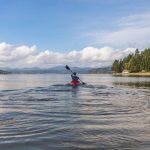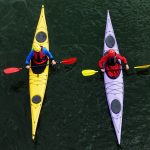If you’re new to the world of water sports, you may be wondering about the difference between stand-up paddleboarding (SUP) and SUP surfing.
While both activities involve standing on a board and using a paddle, there are some key differences that set them apart. Understanding these differences can help you decide which activity is right for you and make the most of your time on the water.
In this article, we’ll explore the similarities and differences between stand-up paddleboarding and SUP surfing, including the equipment you’ll need, the skills required, and the types of conditions each activity is best suited for.
So if you’re ready to dive into the exciting world of water sports, keep reading to learn more!
Paddle boarding and sup surfing – What is the difference?
Paddling on a lake is a much more tranquil experience than taking on the waves of the ocean on a paddle board. Generally, there are fewer swells and breakers to overcome. This leads to a far more reliable and foreseeable outcome.
When paddle boarding in the ocean, you generally have to manage bigger swells and more capricious weather conditions. This can result in a more difficult but invigorating experience.
My personal experience
It is important to take into consideration other influences, such as counter currents and coastal breezes, when riding a SUP board in the sea. My inaugural experience undertaking stand up paddleboarding was out on the sea in Hawaii, with much of my time spent on my knees.
When I got to my feet, I paddled a bit and either the gusts of wind or the uneven waves sent me plunging back once more into the sea.
I assumed I would require the help of the Coast Guard to get me out of my initial stand-up paddle boarding experience!
What are the benefits of paddle boarding on a lake?
The majority of people will find it easier to get to a lake as opposed to an ocean, however, those who live nearby the shoreline are in a privileged position. Though distance can be a factor, you will learn and refine your stand up paddling skills faster if you are in a more tranquil body of water.
Going on a leisurely paddle board journey on calm waters is an excellent opportunity to take in the beauty of the outdoors.
Canoeing with a paddle can assist in toning your muscles and bettering your equilibrium (as long as you are able to remain balanced!).
If you know how to do it properly, paddle boarding can provide you with a great workout, in addition to giving you the opportunity to observe a lot of the aquatic wildlife while you are standing atop your paddle board.
Is it easier to learn on a lake or in the ocean?
When trying to decide whether it would be simpler to master the technique of stand up paddle boarding on calm water or in the sea, there are many elements that need to be taken into consideration.
A few things that can influence how hard paddle boarding is include the type of board, the magnitude of the surf, and the strength of the breeze.
Generally, it will be simpler to learn how to sail on a still body of water than in the open sea. The decreased number of elements that can affect your equilibrium and balance on the skateboard is the reason for this.
When you’re starting out, it is essential to have a steady environment so that you can concentrate on mastering the right methods.
Although it might appear to be an obstacle, that doesn’t mean that gaining knowledge while at sea is out of the question. If you can find a placid body of water with some gentle waves, you should be able to learn the basics of stand up paddle boarding in a short period of time.
Be ready to tackle more difficult conditions than what would typically be present in body of water with no discernable swell.
What are the benefits of paddling in the ocean?
Heading out onto the sea with a stand-up paddleboard can be a real pleasure. Experienced SUPers usually enjoy trying to ride waves.
Stand up paddle boards are so buoyant and the person riding them is standing that they are able to ride significantly small waves which can be very confidence-boosting.
Ensure that you do not try this while in a swimming region.
Ocean SUP surfing basics
Riding your paddle board is not too difficult, though using a shorter paddle than you would on a lake could be beneficial. Additionally, familiarizing yourself with additional methods of paddling like the reverse and forward sweep stroke can be helpful in complimenting the forward stroke and reverse stroke that most boarders already know.
You perform the sweep stroke in a similar way to the usual paddle boarding technique, varying only in that you keep the paddle away from the board by approximately a foot or two so you can swiftly adjust direction when a wave arrives.
In order to master surfing on your paddle board, you should aim to move swiftly and smoothly between a regular SUP stance (bending your knees slightly, having your feet parallel and well apart) to a surfing posture with one foot situated on the back part of the board and the other near the middle, by the grip handle.
When a wave is building up in your background, you should employ a sweeping stroke in order to pivot your board towards the shore. Maintain your feet in a parallel position and propel with your arms outstretched to engage your core muscles.
Then, give your board a few strokes to get it going and make it easier to catch a wave. Your paddling motion should be relatively brief at this juncture. It’s beneficial to rehearse these paddling methods before you find yourself surfing a wave!
Once you are being moved forward by the wave, make a smooth rise as you transfer one foot to the back of the board and the other to the middle.
Change the hold on your SUP paddle to either slow yourself down if you drift too far away from the wave, or to do some more powerful strokes if the wave begins to pull far ahead of you. Try that trick on a surfboard!
And, just like that, you’re SUP surfing!
Stand-Up Paddle Boarding: Paddling Technique
Is paddle boarding hard? We wouldn’t assert that, however we could suggest that it can be daunting, particularly when you’re trying to master the accurate approach. Once you gain proficiency with the fundamentals, you’ll be on the right track.
When holding the oar, have your other hand (left hand for those riding on the right side of the surfboard) positioned on the top handle, and your inward-facing palm should rest on the collumn.
For efficient power while stand-up paddle boarding, reach the end of the paddle as far away from your body as you can and perform the stroke by only using your core muscles until you have crossed your body. Take the next stroke by removing the paddle from the water.
When you are rowing, use your core muscles to power the paddle. Your arms should be fairly straight throughout the process. In order to make paddling easier, consider your body’s relationship to the paddle to be like the shape of an A.
Your arm that is highest in position should reach above your head to grasp the end of the stand-up paddleboard paddle, forming a straight line with the opposite end of the paddle.
The SUP paddle is the other edge of the letter A, and your arm that is the furthest away from your body is the line that goes through the middle of the A. Keep that A formed throughout your stroke.
Alternating Your Paddle Board Stroke
Unless you possess a special racing paddleboard, which typically have sharp V-shaped hulls, you will likely observe a bit of alteration in the direction after each time you paddle.
Your fin size and set up combined with your paddling technique will determine it, but when you do a few paddle strokes on the board’s right side, you may find that you have changed direction and are now going in a leftward angle, somewhere in the ballpark of 15 to 30 degrees.
Now, move over to the other direction and swim five times. You switch between the opposite sides repeatedly and the hand that is at the top changes every time you do.
Take hold of the middle paddle with the hand that is closest to the top of the board as you sail across it, then switch the hand holding the middle paddle to the top. Lean to the side of the paddle while using the edge of the surfboard like a rail.
The bottoms of SUP boards can vary in shape, which affects how the boards move in water. A sizable chunk of becoming proficient in stand-up paddle boarding is determining which SUP boards are most suitable for the SUP outing you intend to have.
See our stand-up paddle boarding board type discussion below.
How to Paddle Surf
Paddle Surfing Is Difficult but Fun
It’s up to the individual to decide whether they would rather use a paddle board or a surf board. Stand-up paddle surfing involves much more than just paddling on a flat surface. Once you have navigated yourself out of the choppy rapids and pounding breakers, you still have to maintain your balance in the steady swell of the sea.
It is especially challenging if you do not have any experience with stand-up paddle boarding in calm waters. The complexity of the problem with balance is further complicated due to the constant shifting of standards, making it difficult to determine what the real level is.
Seeing your feet while paddle boarding can make it harder to balance, so instead of looking down, try to focus on the horizon line or the beach in front of you to maintain equilibrium. That’s your level. Forget your feet.
If you focus on the horizontal line in front of you, your body and the paddle board will take care of themselves. In addition, this is how one can prevent nausea while on a boat.
Paddle Surfing Strategy: Navigating the Break
Mastering the technique of stand-up paddle surfing can be tricky, particularly conquering rough waters and big waves. Prior to being able to ponder your approach to riding a wave, you must initially position yourself beyond the waves that are crashing.
Having a large SUP board makes this even more challenging. It’s wise to pause and observe the ocean before taking off on your initial paddle surfing experience.
See if there is a location where the surf is constantly forming crests (the most distant and central spot at which it is crashing). Normally, the wave reaches its highest point in one area and then disperses towards the side, gradually diminishing.
It is advisable to go out to the side of the wave break instead of right in the middle of it. Doing this is beneficial for two reasons; it facilitates a swift exit, and also helps to prevent obstructing other surfers or paddle boarders if you attempt to exit the wave from the inside.
Paddle Surfing in Closed-Out Areas
In many locations, the waves all collapse or become unrideable at the same time. As a novice on a stand-up paddle board, you’ll be able to gain experience in an environment that will not be crowded with experienced “good surf spots” paddle surfers.
You are a threat to those around you as you have not yet mastered the skill and you are carrying a large stand-up paddle board which could cause injury to other people if you are not in control.
When paddling in these areas, select the best option available. Ultimately, you will inevitably be caught amid the turbulent waves and frothy water.
It is recommended that you remain in the turbulent area created by the waves until the wave set is finished and then you can move forward towards the outer section of the ocean. In a crowded area, it’s impolite to surf through the wild foam while a swarm of other surfers is approaching, as this would interrupt their experience.
It’s perfectly fine (and recommended) to paddle on your knees and use a shorter paddle while making quick, concise strokes whenever you have an opportunity to surface in the waves and whitewater.
It can be difficult to master how to stand-up paddle surf, so don’t be embarrassed if you have to kneel at certain points and get back to your regular stand-up paddle surfing posture when things become easier.
This isn’t the time for dillydallying when you are paddling through the water on a stand up paddle board. Your best bet is to leave the area quickly and not dilly-dally, so use your paddle to your advantage. You can rest once you’re outside the breaking waves.
Fortunately, it’s possible for a stand-up paddle boarder to paddle at a rate that’s three times faster than a prone surfer, so you can move from one place to another much faster. It may take longer when you’re on your knees, but having a paddle is still a pleasant experience.
Conversely, surfers have the option to duck-dive under or do turtle rolls with waves, whereas paddle boarding requires that the wave be ridden over the top. Take advantage of your speed while paddle surfing and avoid ending up in a place at an inopportune time.
in conclusion
While stand-up paddleboarding and SUP surfing share some similarities, they are distinct activities with unique challenges and rewards.
Whether you’re looking for a peaceful paddle along calm waters or an adrenaline-fueled ride on the waves, there is a water sport out there for you.
By understanding the differences between stand-up paddleboarding and SUP surfing, you can make an informed decision about which activity is best suited to your interests and skill level.
So grab your board and paddle, and get ready to experience the thrill of the open water!




